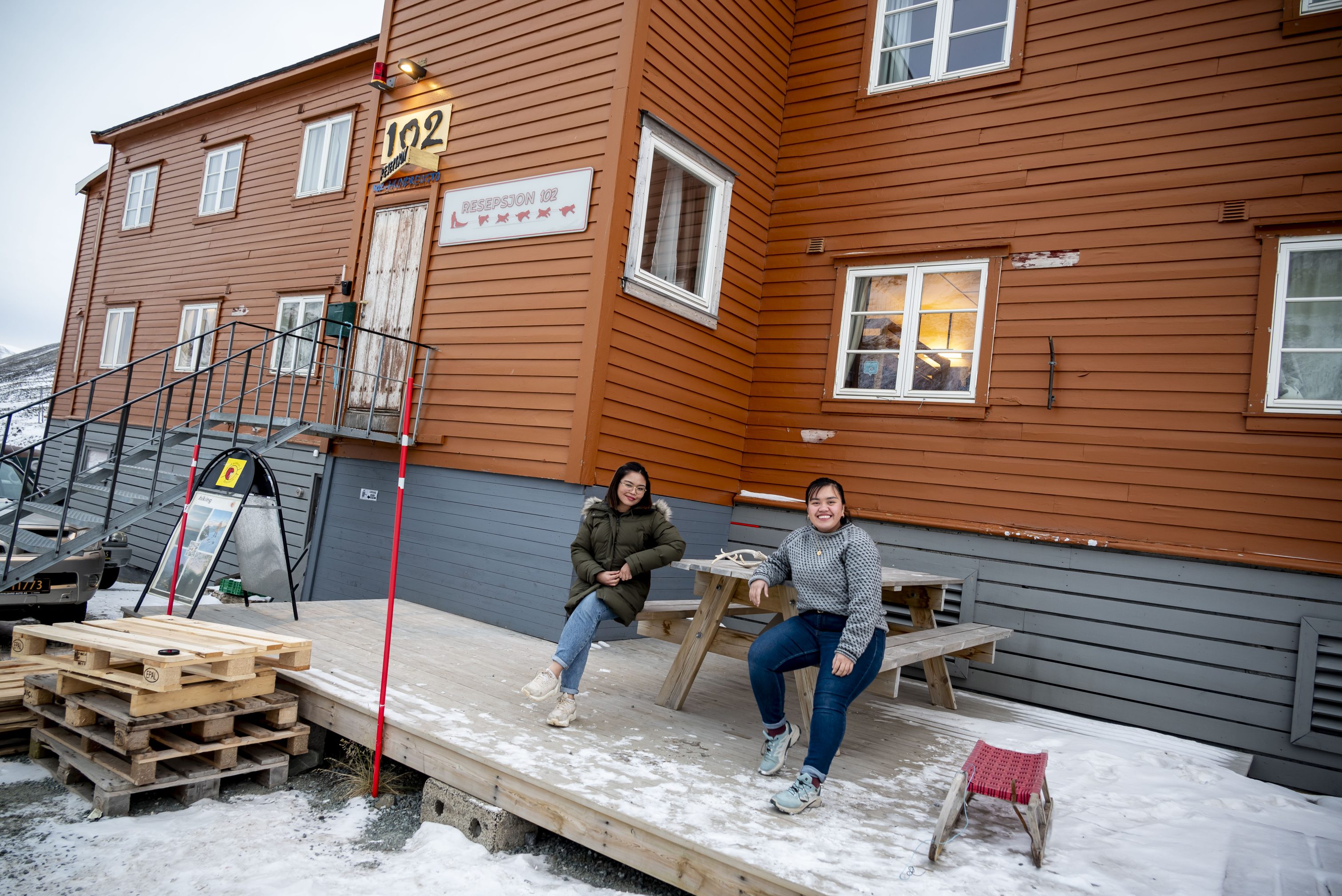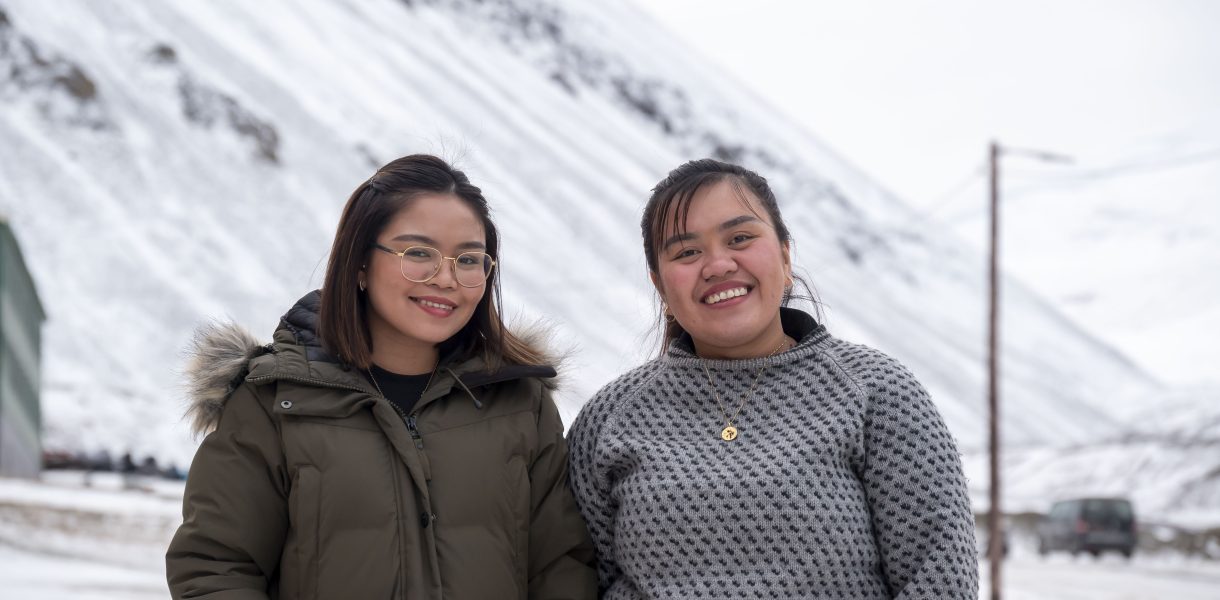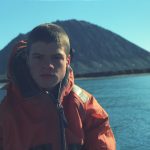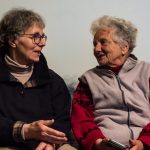English version below
Pod lodowcem Longyear, na końcu miasta stoi dom, którego pilnuje wiatr. Ściany trzeszczą i gwiżdżą pod jego naporem, grają dźwięki, ingerując w strukturę budynku. W środku toczy się zupełnie inna symfonia. Tworzą się wspomnienia i zapisują historie. W każdym kącie, w każdej szparze tkwi opowieść. Napisana przez tych, którzy po przekroczeniu progu mogą nazwać to miejsce domem, ale też przez tych, którzy się nim opiekują. Dla wielu droga na Svalbard nie jest łatwa. Ale czy Północ właśnie taka nie jest? Dla każdego pisze osobną historię. Urok mroźnej wyspy jak magnes ściąga ludzi z przeróżnych zakątków świata. Khristin Aina Galang Grana i Angie Bardoquillo los przywiódł na Svalbard z Filipin. Chociaż ich rodzinny dom to zupełnie inna bajka, tą własną od kilku lat piszą w Longyearbyen.
Z przyjaciółkami z Gjestehuset 102 rozmawiam o wpływie zmian klimatu na codzienne życie mieszkańców Longyearbyen, turystyce rozwijającej się na Svalbardzie, a także o historii ich przeprowadzki na Północ z tak odległego zakątka świata.
Obie mieszkacie na Svalbardzie od kilku lat. Jakie zmiany zauważyłyście z powodu zmian klimatu? I jak wpływają one na codzienne życie na wyspie?
Angie: Nie przypominam sobie, żebym po 2019 roku kiedykolwiek doświadczyła tak ekstremalnie niskiej temperatury. Nigdy nie zapomnę widoku pięknego, zamarzniętego Adventfjorden, który mogłam wtedy zobaczyć. Od tego czasu nie widziałam go zamarzniętego. Do 2021 roku ocieplało się, zdecydowanie nie było zbyt wielu zimnych, rześkich dni. Zawsze padał śnieg, więc lewa strona Nybyen musiała zostać ewakuowana ze względu na ogromną ilość śniegu nagromadzonego w pierwszych miesiącach zimowych. Latem, w czerwcu 2021 roku temperatura wahała się od 23 do 26 stopni. Mieliśmy najwyższą zarejestrowaną letnią temperaturę od ponad stu lat. Było bardzo ciepło. Wszyscy nosili szorty. Zabawnie się na to patrzyło, ale kiedy myśli się o stojącej za tym rzeczywistości, to właściwie jest to smutna historia.
Wolicie tropiki czy Svalbard?
Khristin: Wolę, kiedy jest zimno. Mieliśmy kiedyś gościa z Serbii, który mieszka we Włoszech, i zapytałam go, który kraj woli. Powiedział, że kocha Włochy, ale jego serce należy do Serbii. Potem zadał mi to samo pytanie. Po sześciu latach mieszkania na Svalbardzie czuję się jak w domu, ale oczywiście, moja rodzina i przyjaciele są na Filipinach. Zawsze będę chciała do nich wracać, ale nie wyobrażam sobie mieszkać tam na stałe.
Opowiedzcie o swoim ulubionym miejscu na Svalbardzie.
Angie: Niestety nie jestem aż tak aktywna na zewnątrz w otoczeniu dzikiej natury w porównaniu z typowym Svalbarczykiem. Moje ulubione miejsce to droga do centrum miasta, z widokiem na Hiorthfjellet, górę znajdującą się naprzeciw. Jest piękna, szczególnie podczas tzw. niebieskiej godziny, gdy pokrywa ją śnieg, a niebo jest czyste. Góra jest idealnie usytuowana. Doceniam przyrodę, którą można zobaczyć, po prostu się rozglądając, i to jest jedna z rzeczy, które lubię robić – robić zdjęcia naszego małego, pięknego miasteczka i dzielić się nimi ze światem.
Odwiedziłyście Ny-Ålesund?
Khristin: Byłam w Ny-Ålesund w ramach czterodniowej ekspedycji. Był to jeden z przystanków wycieczki. Nie przepadam za dużymi miastami, są dla mnie przytłaczające. Lubię mieszkać w Longyearbyen, ponieważ to małe miasto. Moje ulubione miejsce na Svalbardzie to Bjørndalen. Kiedy tam jedziesz, czujesz się jak w innym świecie. Można zobaczyć wybrzeże i lodowce na zachodzie. Jest tam spokojnie. Bardzo lubię też Sarkofagen i Platåfjellet, ale nie mogę tam chodzić kiedy chcę, ponieważ nie mam broni.
Trzeba być otwartym i chętnym do zrozumienia ludzi, kultury, a zwłaszcza środowiska. Jako gość musisz być odpowiedzialny. Mamy wytyczne dotyczące tego, co robić, a czego nie robić, gdy przyjeżdża się do Longyearbyen. Są to zasady zdrowego rozsądku i należy ich przestrzegać. Nie zrywaj kwiatów. Nie rób zdjęć dzieciom w przedszkolu. Nie rób zdjęć ludzi i ich mieszkań. Szanuj kulturę, dziedzictwo i budynki kulturalne. Miej otwarty umysł.
Jaka jest najważniejsza wiadomość, którą chciałybyście przekazać turystom odwiedzającym Svalbard w kontekście środowiska i unikalnego ekosystemu tego regionu?
Khristin: Powiedziałbym, że warto przyjechać na Svalbard nie tylko z jednego powodu. W przeciwnym razie prawdopodobnie poczujesz rozczarowanie. Na przykład, jeśli chcesz tylko zobaczyć niedźwiedzia polarnego, nie sądzę, że jest to właściwe nastawienie. Trzeba być otwartym i chętnym do zrozumienia ludzi, kultury, a zwłaszcza środowiska. Jako gość musisz być odpowiedzialny. Mamy wytyczne dotyczące tego, co robić, a czego nie robić, gdy przyjeżdża się do Longyearbyen. Są to zasady zdrowego rozsądku i należy ich przestrzegać. Nie zrywaj kwiatów. Nie rób zdjęć dzieciom w przedszkolu. Nie rób zdjęć ludzi i ich mieszkań. Szanuj kulturę, dziedzictwo i budynki kulturalne. Miej otwarty umysł. Wszystko, co widzisz, jest piękne. Jeśli więc przyjedziesz i nie zobaczysz niedźwiedzia polarnego, ciesz się, że możesz poznać lodowce, góry i ludzi. I proszę, bądź grzeczny.

Co myślicie o rozwijającej się turystyce?
Khristin: Pracujemy w turystyce, ale jako że Svalbard to nasz dom, wiemy o tym miejscu więcej niż turyści. To kruche środowisko, więc ważne, aby o nie dbać. Jeśli nie możemy kontrolować liczby turystów, przynajmniej możemy ich prowadzić w działaniach. Powinni przestrzegać wytycznych i postępować świadomie, ponieważ nie jest typowy kierunek turystyczny.
Angie: Doceniamy turystów i cieszymy się, widząc ich szczęśliwych, eksplorujących Svalbard.
Khristin: Szkoda tylko, że niektórzy turyści nie są świadomi środowiska, w którym się znajdują, kiedy przyjeżdżają po raz pierwszy na Svalbard. Pytają, czy są wycieczki, na których można polować na niedźwiedzie polarne. Nie można tu polować na niedźwiedzie polarne. Svalbard nie ma zoo z niedźwiedziami polarnymi. Tacy turyści są źle poinformowani. Powinni poszukać więcej informacji i przyjechać przygotowani.
Czy to prawda, że ludzie przyjeżdżają do Gjestehuset 102, aby doświadczyć polarnych nocy przez dwa lub trzy miesiące?
Khristin: Tak, oferujemy w hotelu specjalną ofertę na ciemny sezon. Można wynająć pokój na dłuższy czas w specjalnej cenie.
Czy każdy może tu mieszkać i pracować?
Angie: Zasadniczo tak. Ale trzeba być w stanie zapewnić sobie utrzymanie, w tym zakwaterowanie i wyżywienie.
Co was zmotywowało do przeprowadzki?
Khristin: Często, gdy pytasz ludzi, którzy się tu przeprowadzili o ich historie, mówią, że przyjechali jako turyści i zakochali się w tym miejscu, więc postanowili zostać. Ale ja przybyłam z Azji, moja historia jest inna. Początkowo moim powodem przeprowadzki na Svalbard były cele ekonomiczne. Najpierw przyjechałam do Norwegii z wizą au pair. Pracowałam w Oslo przez dwa lata, ale się nie udało. Nie chciałam wracać na Filipiny, więc postanowiłam przyjechać tutaj i zobaczyć, czy znajdę pracę na Svalbardzie. Pięć lat później nadal tu jestem. Zakochałam się w tym miejscu, ale nie miałam innego wyboru, ponieważ z naszymi paszportami możemy mieszkać i pracować tylko w Norwegii lub na wyspie. Myślę, że to nie była tylko motywacja. Los mnie tu przywiódł. Kocham Svalbard i wierzę, że tak miało być.
Doświadczyłyście tutaj dyskryminacji?
Angie: Norwegowie są naprawdę mili, więc w ogóle nie doświadczyłam bezpośredniej dyskryminacji. Są serdeczni, zwłaszcza jeśli chcą okazać wdzięczność jako pomocni miejscowi, dobrzy koledzy, pracownicy. Nie mam wielu przyjaciół ani dużej sieci kontaktów, co sprawia, że czasami zadaję sobie pytanie, dlaczego tak jest. Część mnie czasami myślała, że może to być spowodowane kolorem mojej skóry, może nie wyglądam tak interesująco jak inni, ale nie, to nie o to chodzi. Po prostu rzadko wychodzę do ludzi, nie jestem też zbyt dobra w rozpoczynaniu rozmów, chyba, że jestem na miejscu, w recepcji pensjonatu, gdzie zapewniam, że możemy rozmawiać cały dzień o wszystkim! Ale oczywiście zastanawiam się, jak widzą mnie biali miejscowi, jak widzą nas. Zwłaszcza ci potężni.
Nadchodzą polarne noce. Jak czujecie się bez słońca?
Khristin: Może mieć to wpływ na ludzi. Nie odczuwałyśmy tego podczas pierwszych dwóch ciemnych sezonów, ale ostatnie dwie noce polarne naprawdę na nas wpłynęły. Czułam się bardzo smutna i szukałam potwierdzenia na Instagramie. Chciałam wiedzieć, czy inni ludzie czują to samo. Pisali w komentarzach, że każdy tego doświadcza, a moje uczucia są normalne. Noce polarne wpływają na energię i człowiek czuje się przygnębiony. Tym razem spróbujemy poradzić sobie z tymi ciemnymi myślami, będąc zajętymi i dbając o nasze zdrowie psychiczne i ciała. Z drugiej strony, kochamy spokój, jaki Svalbard oferuje podczas nocy polarnych.
Czy to prawda, że w Longyearbyen ludzie nie zamykają drzwi ani samochodów?
Angie: Tak, to prawda, choć zaczęłam zamykać drzwi, ponieważ chciałam być w 100% pewna, że nikt nie wejdzie do mojego mieszkania. Mieszkam w kompleksie mieszkaniowym, gdzie wszystkie drzwi mają ten sam kolor i kilka razy zdarzyło się, że ktoś przez pomyłkę wszedł do złego mieszkania. Łatwo denerwuję się hałasem, a usłyszenie czegoś za drzwiami powoduje, że za dużo myślę. Gdyby to był Rhysand, byłby mile widziany!
Khristin: Nie zamykam drzwi. Może to zaufanie do ludzkości albo akceptacja losu.
Czujecie się tu spokojniejsze?
Khristin: Czasami jest zbyt spokojnie. Zdecydowanie rozwinęłam się tutaj i poszerzyłam moje horyzonty. Życie na Svalbardzie mnie zmieniło. I nadal zmienia.
Angie: Zgadzam się. Poznałyśmy wielu miłych ludzi z różnych kultur o różnych sposobach myślenia, czy to o życiu, logicznie lub emocjonalne. Wspaniale jest spotykać i poznawać ludzi o różnych perspektywach życiowych, zawsze mnie to fascynowało, chociaż nie oznacza to, że muszę zgadzać się ze wszystkim, co mówią. Świat jest naprawdę rozległy i tak, doceniamy życie tutaj.
Khristin: Kiedy tu przyjechałyśmy, było dużo presji i obowiązków ze strony naszych rodzin, przyjaciół i nas samych. Ale po przeprowadzce otworzyłam oczy. Życie jest krótkie, więc ciesz się rzeczami i jednocześnie rób rzeczy, które są tego warte.
„It’s a fragile environment, so it’s important to take care of it”. Khristin Aina Galang Grana and Angie Bardoquillo about living on Svalbard
Under the Longyear glacier, at the end of the town, stands a house guarded by the wind. Walls creak and whistle under its pressure, making sounds, interfering with the structure of the building. Inside, a completely different symphony unfolds. Memories are formed and stories are recorded. In every corner, in every crevice, there’s a story. Written by those who, after crossing the threshold, can call this place home, but also by those who take care of it. For many, the journey to Svalbard is not easy. But isn’t that just what the North is like? It writes a separate story for everyone. The charm of the frosty island draws people from all corners of the world like a magnet. Fate brought Khristin Aina Galang Grana and Angie Bardoquillo to Svalbard from the Philippines. Although their family home is a completely different story, they have been writing their own tale in Longyearbyen for several years.
With friends from Gjestehuset 102, I talk about the impact of climate change on the daily life of Longyearbyen residents, tourism developing in Svalbard, and the story of their move to the North from such a distant corner of the world.
Both of you have been living in Svalbard for a few years. What changes have you noticed here due to climate change? And how do they affect daily life on the island?
Angie: After 2019 I really couldn’t remember experiencing that extreme low temperature anymore. I would never forget the look of the beautiful frozen Adventfjorden I was able to see that year. I haven’t seen that frozen again since then. By 2021, it really began to warm up, not a lot of cold crisp days definitely, it was always snowing that the left side of Nybyen had to be evacuated due to the extreme amount of snow accumulated from the early winter months. The summer of 2021, in June, was between 23 to 26 degrees. We had the highest recorded summer temperature in over 100 years. It was very warm. Everyone was wearing shorts. It was amusing to see, though, but when you think about the reality behind it, it’s actually quite a sad story.
Do you prefer tropical places or Svalbard?
Khristin: I prefer it when it’s cold. Once, we had a guest from Serbia, who lives in Italy, and I asked him which country he prefers. He said, I love Italy, but my heart belongs to Serbia. Then he asked me the same question. Svalbard feels like home to me now, after living here for six years, but of course, my family and my friends are in the Philippines. I will always want to return to them, but I don’t see myself living there permanently.
Tell us about your favourite place on Svalbard.
Angie: Unfortunately, I am not that so active outside the far nature compared to the typical local Svalbardian. I do enjoy taking short walks though. My favorite spot is on the way to the town center, facing Hiorthfjellet, a mountain directly in front of you. It’s just so beautiful, especially during the blue hour, when it’s full of snow and the sky is clear. The mountain is perfectly situated. I appreciate the nature you can see just by looking around and that’s one of the thing I enjoy doing- to take pictures of our small beautiful town, and share it to the world
Have you been to Ny-Ålesund?
Khristin: Yes, I went to Ny-Ålesund as part of a 4-day expedition, it was one of the stopovers of the trip. I am not fond of big cities, it is overwhelming for me. So I like living in Longyearbyen since it is a small town. My favorite place in Svalbard is Bjørndalen, when you drive up there, it feels like you are in a different world. You can see the coast and the glaciers to the west. It’s peaceful there. I also really like Sarkofagen and Platåfjellet, but I can’t go there whenever I want since I don’t have a weapon.
You have to be open and willing to understand the people, culture, and especially the environment. You need to be responsible as a visitor. We have guidelines on what to do and what not to do when you come to Longyearbyen. They are common sense rules, and you should follow them. Don’t pick flowers. Don’t take photos of children in the kindergarten. Don’t take pictures of people and their apartments. Respect the culture, heritage, and cultural buildings. Keep an open mind.
What is the most important message you would like to convey to tourists visiting Svalbard in terms of the environment and the unique ecosystem of this region?
Khristin: I would say come to Svalbard not just for one reason. Otherwise, you’ll likely be disappointed. For example, if you only want to come to see a polar bear, I don’t think that’s the right mindset. You have to be open and willing to understand the people, culture, and especially the environment. You need to be responsible as a visitor. We have guidelines on what to do and what not to do when you come to Longyearbyen. They are common sense rules, and you should follow them. Don’t pick flowers. Don’t take photos of children in the kindergarten. Don’t take pictures of people and their apartments. Respect the culture, heritage, and cultural buildings. Keep an open mind. Everything you see is beautiful. So, if you come and don’t see a polar bear, be happy to experience the glaciers, the mountains, and the people. And please, be polite.

What do you think about tourism, which is growing all the time here?
Khristin: It’s ironic because we work in tourism, but since Svalbard is our home, we know more about this place than the tourists. It’s a fragile environment, so it’s important to take care of it. If we can’t control the number of tourists, at least we can guide them on what to do. They should follow the guidelines and be more mindful because this is not your typical tourist destination.
Angie: We do appreciate tourists, and we love to see them happy while exploring Svalbard.
Khristin: It’s just a shame that there are some tourists who are not so aware of the environment they are stepping into when they come the first time in Svalbard. They ask questions like, “is there a tour where we can chase polar bears?” You can’t just chase polar bears here. Svalbard doesn’t have a zoo with polar bears. These type of tourists are not well-informed. They should do a little more research and come prepared.
Is it true that people come to Gjestehuset to experience the polar nights for two or three months?
Khristin: Yes, we offer a dark season special at the hotel. You can rent a room for a long term at a special rate.
Can anyone live and work here?
Angie: Basically, yes. But you have to be able to sustain yourself, including accommodation and food.
What motivated you to move here?
Khristin: Often, if you ask people who have moved here about their stories, they’ll say, 'I came here as a tourist and fell in love with the place, so I decided to stay.’ But coming from Asia, my story is different. My initial reason for moving to Svalbard was for economic purposes. I first entered Norway on an au pair visa. I worked in Oslo for two years, but it didn’t work out. I didn’t want to return to the Philippines, so I decided to come here and see if I could find a job on Svalbard. Five years later, I’m still here. I fell in love with this place, but I also had no other choice because, with our passports, you can only stay and work in Norway or on the island. I think it wasn’t just motivation; it was fate that brought me here. I love Svalbard, and I believe it was meant to be.
Do you experience discrimination here?
Angie: The Norwegian people are really nice, so I haven’t experienced direct discrimination at all. They are warm especially if they want to show their appreciation to you as a helping local, or a good colleague, employee, anything. I do not have many friends or a large network, which makes me sometimes question myself why this is the case. Part of me would sometimes think that it could be because of my skin color, maybe I do not look as interesting as the others, but no, this isn’t the case. I just really do not go out often to meet people, and I am also not really good with starting conversations, unless maybe I am on my spot, at the guesthouse reception, where I can assure you we can talk all day about anything! But of course, I wonder how white local people see me, see us. Especially those mighty, powerful ones.
The polar nights are coming. How do you feel without the sun?
Khristin: It can really have a negative effect on people. We didn’t feel it during our first two dark seasons. But the last two polar nights really affected us. I felt very sad and had to seek validation on Instagram. I also wanted to know if other people felt the same. They left comments like, ‘Everyone else here is experiencing the same. Your feelings are normal.’ Polar nights really affect your energy, and you feel low. This time, we’ll try to manage these dark thoughts by staying busy and taking care of our mental health and bodies. On the other hand, we love the peace that Svalbard offers during the polar nights.
Is it true that in Longyearbyen, people don’t lock their doors or cars?
Angie: Yes, it’s true, but I started locking my door because I wanted to be 100% sure that nobody would come into my apartment. I live in an apartment complex where all the door colors are the same, and it has happened a few times that someone went to the wrong apartment by mistake. I easily get disturbed with noise and hearing something on the door will just make me overthink. If it were Rhysand, High Lord of the Night Court, he’d be welcome!
Khristin: I don’t lock the door. Maybe it’s trust in humanity or accepting your fate.
Do you feel more peaceful here?
Khristin: Sometimes it’s almost too peaceful. I’ve definitely grown and broadened my horizons here. Living on Svalbard has changed me. And still changing.
Angie: I agree. We’ve met a lot of nice people from different cultures, with different ways of thinking, be it about life; the logical or emotional. It is amazing to meet and know people with different life perspectives, it always fascinated me even though it doesn’t mean I have to agree to everything they say. The world is indeed broad, and yes we appreciate life here.
Khristin: When we came here, there was a lot of pressure and responsibilities from our families, friends, and ourselves. But after moving, I opened my eyes. Life is short, so enjoy things and, at the same time, do things that are worth doing.
Kontynuuj podróż:




Woah! I’m really digging the template/theme of this site.
It’s simple, yet effective. A lot of times it’s hard to get that „perfect balance” between user friendliness and visual appeal.
I must say you’ve done a excellent job with this.
Also, the blog loads extremely quick for me on Safari.
Outstanding Blog!